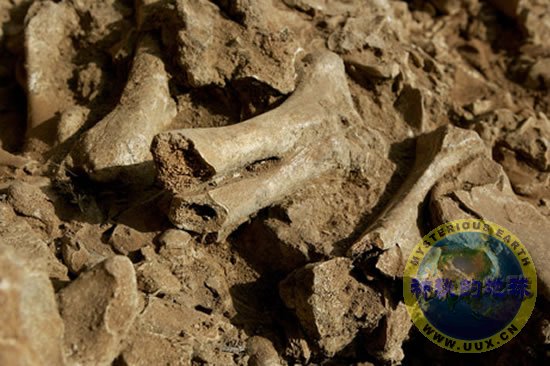Dwarf Hippo Fossils Found on Cyprus
The fossilized remains of dozens of dwarf hippopotamuses lie in an excavated cave outside the resort village of Ayia Napa, some 40 miles (65 kilometers) southeast of Cyprus' capital Nicosia, on November 28, 2007.
Scientists believe the fossil haul may hold clues about early human activity on the island.
Photograph by Petros Karadjias/AP
Menelaos Hadjicostis in Ayia Napa, Cyprus
Associated Press
December 6, 2007
A collapsed cave filled with the fossilized remains of extinct dwarf hippopotamuses may hold clues about early human activity on the island of Cyprus, according to Cypriot and Greek scientists studying the site.
Recent digs at the cave just outside the resort of Ayia Napa have yielded fossils of an estimated 80 dwarf hippos—descendants of hippos believed to have reached the Mediterranean island about a quarter-million years ago.
Hundreds more may lie beneath an exposed layer of jumbled fossils.
Scientists hope the fossil haul, tentatively dated to 9,000-11,500 B.C., will offer clues about when humans first arrived on the island.
"It's about our origins," said Ioannis Panayides, the Cyprus Geological Survey Department official in charge of the excavations in conjunction with the University of Athens. "Knowledge of our geological history makes us more knowledgeable about ourselves."
In the Past
Before the Ayia Napa discovery, the earliest trace of humans on Cyprus dated to 8,000 B.C. But signs of human activity at the new dig could turn back the clock on the first Cypriots by as much as 3,500 years.
"That's very significant, but we can't be certain yet. The task of examining is laborious and time consuming," said University of Athens Professor George Theodorou, who is tasked with examining some one and a half tons of fossils.
The dwarf hippopotamuses were herbivores, like their modern cousins, but were only about two and a half feet (75 centimeters) tall and four feet (120 centimeters) long.
Unlike modern hippos, whose upturned nostrils seem designed for swimming, Cypriot hippos had low-slung nostrils better suited to foraging on land.
Panayides said the fossils show the Cypriot hippos' legs and feet were also adapted to land, enabling them to stand on their hind legs to reach tree branches.
Experts believe hippos arrived on Cyprus between 100,000 to 250,000 ago and likely got smaller to adapt to the hilly, island landscape. But scientists do not know how the animals reached Cyprus, which is not known to have ever been physically linked to another land mass.
Panayides said paleontologists theorize hippos may have swum or floated here during the Pleistocene ice age from land that is now Turkey or Syria. They may have clung to tree trunks and other debris during the crossing. (See map.)
Lower sea levels at the time made Cyprus much larger than its present 3,570 square miles (9,250 square kilometers), so it was much closer to other lands. By some estimates, what is now Syria was a mere 18 miles (29 kilometers) away.
Dwarf Hippo-Human Link
Digs over the last century uncovered smaller numbers of dwarf hippo fossils at 40 locations across Cyprus. One cave found 20 years ago had evidence of fire, stone tools, and scorched bones, indicating dwarf hippos were hunted by humans.
Carbon dating on those hippo fossils showed the site dated to 8,000 B.C. Evidence of human activity at Ayia Napa means the island may have been settled by humans as much as 3,500 years earlier.
A human footprint at the Ayia Napa site could bolster the theory that the island's earliest inhabitants could have driven the dwarf hippos to extinction through hunting, said Panayides.
"If these new bones are found to be older than bones previously discovered and scientists can find an association with humans, then the discovery has the potential to tell us more about the island's first human inhabitants," said Eleanor Weston, a paleontologist at London's Natural History Museum who was not connected with the Ayia Napa discovery.
Panayides said indications that hippo bones at Ayia Napa had been crushed as if trampled by other hippos, suggesting successive generations came to the cave. Shelter is the most likely explanation, but Panayides didn't rule out the possibility the hippos returned to an ancient burial ground to die.
Copyright 2007 Associated Press. All rights reserved. This material may not be published, broadcast, rewritten, or redistributed.












